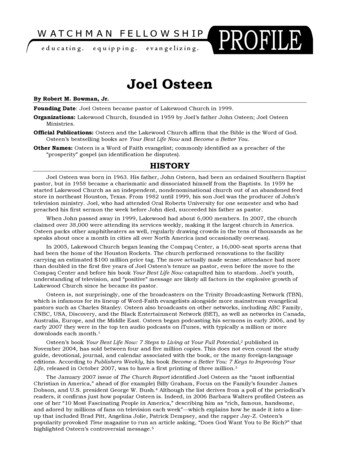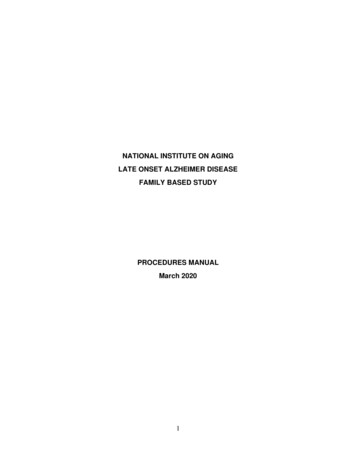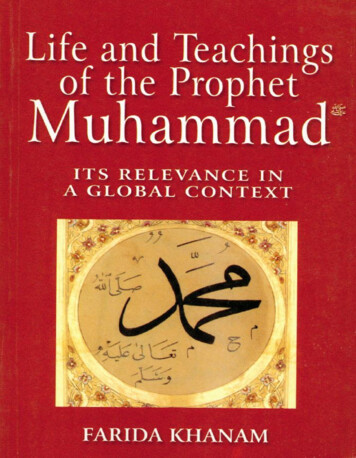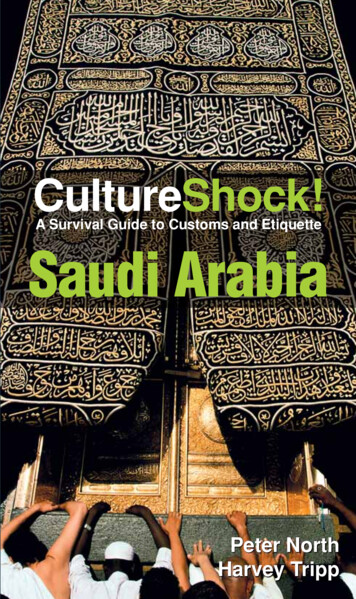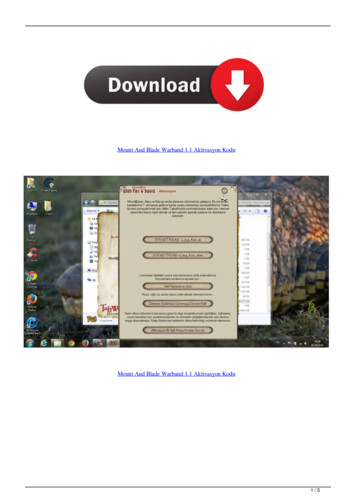
Transcription
M OUNT SINAI IN ARABIACopyright 2018 by Joel RichardsonAll rights reserved. No part of this book may be reproduced in any form or by any means—whether electronic, digital, mechanical, or otherwise—without permission in writing fromthe publisher, except by a reviewer, who may quote brief passages in a review.Unless otherwise marked all maps and images are courtesy of the author. The images on pagesb and c in the photo insert are from Getty Images.Unless otherwise indicated, all Scripture references are from the New American StandardVersion (NASB). Copyright 1960, 1962, 1963, 1968, 1971, 1972, 1973, 1975, 1977,1995 by The Lockman Foundation. Scripture marked niv is from the Holy Bible, NewInternational Version , niv Copyright 1973, 1978, 1984, 2011 by Biblica, Inc. Usedby permission. All rights reserved worldwide. Scripture marked esv is from the Holy Bible,English Standard Version. esv Text Edition: 2016. Copyright 2001 by Crossway Bibles, apublishing ministry of Good News Publishers. Scripture marked isv Copyright 1995-2014by isv Foundation. ALL RIGHTS RESERVED INTERNATIONALLY. Used by permissionof Davidson Press, LLC.Paperback ISBN: 978-1-949729-04-7eBook ISBN: 978-1-949729-05-4Book designed by Mark KarisPrinted in the United States of America1 2 3 4 LBM 21 20 19 18
To the God of Sinai and to the small band of forerunners who’ve bornboth the stigma and the pain of carrying His burden for this mountain.
CONTENTSAcknowledgmentsxIntroduction11The Traditional Site of Mount Sinai72The Modern Search for the Real Mount Sinai133Losing the Yam Suph194The Exodus Sea Crossing275Mount Sinai in the Land of Midian476Ancient Jewish, Christian, and Islamic Traditions677Paul’s Journey to Mount Sinai778Paul Located Mount Sinai in Arabia859Jebel al-Lawz9510The Rocks Cry Out105Epilogue: Approaching the Holy Mountain121Appendix: Responding to Miscellaneous Objections127Notes143Index154
ACKNOWLEDGMENTSI would like to thank Jim and Penny Caldwell for carrying theburden that the Lord has placed in your hearts for this mountainso faithfully. Thank you for your assistance before the trip andfor a blessed time of fellowship after my return. My prayers arethat you would be able to both see and taste the good fruit of allyour labors. I would like to thank Geoff Stone not only for yourexcellence in editing but also for all of your assistance, guidance,and advice. Thank you to Mark Karis for your great ideas, sharpeye, and skills. You always do a great job. Thank you to William Struse for your constructive criticism and assistance. I’mforever indebted to my wife, Amy, for all of your support andtremendous patience as I travel all over the world stirring up allkinds of spiritual hornet’s nests. You’re a true woman of God andI’m so grateful for you. Finally, all thanks and praise belong toJesus, my deliverer, my sustainer, my longing, and my only hope.All the nations shall come and worship before you. Maranatha.vi
INTRODUCTIONIt was 2:30 in the morning when a small group of six were anxiously navigating two Toyota Land Cruisers through the night,down an extremely remote and unpaved desert road in northwest Saudi Arabia. We were doing our best to slip quietly pasta dozen or so Bedouin camps and reach our destination beforethe first call to prayer at about 4:30 a.m. As we approached themountain range known as Jebel al-Lawz, we eagerly scannedthe side of the road for a path that we would follow deep intoa valley, where we would park our vehicles out of site and sleepon the desert floor for maybe an hour. Our goal was to climbto the top of the mountain that the Bible calls Mount Sinai.In years past, large sections of the mountain had beenfenced off and declared to be haram—forbidden. Gun-totingsecurity guards were stationed in guard shacks at the mountain’sbase. In more recent years, the security had been loosened; theguards had disappeared and portions of the fencing had beenknocked over. It had all become somewhat blurry as to exactly1
MOUNT SINAI IN ARABIAwhat was legal and what was not. From all reports that we hadheard, trying to explore the mountain was a gamble. Parts ofthe northwestern regions of Saudi Arabia are somewhat likethe wild west. My friend and guide had traveled there twice inrecent years and on one of the trips had been arrested. Otherswho had recently visited related that depending on who you raninto, the locals could either be very friendly or downright hostile.All things considered, we didn’t want to take any chances. Wedecided to slip in as covertly as possible. We finally found thepath to our hiding spot in the valley, killed the engines, and didour best to take a 4:00 a.m. power nap.Just a couple hours later, with the hot, Saudi Arabian sunrising fast, we were hiking up an incredibly rugged mountain.It was absolutely stunning. Many weeks before I departed, as Iwas preparing for the trip and pondering what I was about toencounter, I felt a sense of holy fear creep over me. Nothing,however, could prepare me for the awe I felt actually being there.For the next three days, we continued to explore the mountainand many of the areas around it. The sense of wonderment neversubsided, and I’m still carrying it with me.As I climbed the mountain, I reflected on its significance.There is something about Mount Sinai that is difficult to putyour finger on. This was the actual location of the most powerful, open theophany in all of redemptive history. At no otherplace throughout all of human history has God ever manifestedHimself before such a large number of witnesses in such an openand powerful way as He did at this mountain. This was the veryplace where God Himself “came down.” This was the mountaindescribed in the New Testament as having been covered in “ablazing fire” in “darkness and gloom and whirlwind,” where2
Introductionthose present heard “the blast of a trumpet and the sound ofwords which sound was such that those who heard beggedthat no further word be spoken to them” (Hebrews 12:18-19).Even Moses, upon seeing such a sight, proclaimed, “I am fullof fear and trembling” (v. 21). This is also the mountain whereElijah fled to and heard the “still small” voice of God. As wewill discuss later, it is also likely the place where Paul the apostletraveled to shortly after his conversion experience on the roadto Damascus and where he would receive a fuller revelation of“his gospel” from heaven. This is a mountain that is literallydrenched with divine history. I’m not normally one who is toosensitive to such things, but when I was there, it was as if I couldstill feel the echoes and reverberations of all that unfolded inthat place so long ago. I’ve traveled all over the world; I’ve beento Israel several times. There is no question that visiting theactual locations where the biblical prophets, John the Baptist,Jesus, and the disciples lived and ministered is a deeply movingexperience. Visiting Jebel al-Lawz, however—which I very muchbelieve to be the true Mount Sinai—was the single most soulstirring and faith-building experience of my life.I’ve always been someone who, when he discovers or experiences something of excellence, loves to share it with others. Assuch, my prayer for this book is that it will contribute in someway to seeing this mountain set apart and preserved as a WorldHeritage Site and opened to the world in order that a multitudeof others can also visit the “mountain of God” and experience thesame sense of holy awe that I felt, to witness such a critical historical location, and to feel those same holy reverberating echoes.To be clear, while this book presents the case for Jebel alLawz as the true Mount Sinai, by no means is it a comprehensive3
MOUNT SINAI IN ARABIAtreatment of the subject. Exodus studies can quickly becomequite complex and any thorough treatment of the subject wouldrequire a substantially larger volume than this. The problem isthat those kind of works only appeal to a very small number ofspecialists and scholars. That is not what this book is. This bookis my best effort to unpack the most important underlying issues,while responsibly interacting with the most up to date and bestscholarship on this subject, and to present my findings in a waythat any reader can easily understand and appreciate. As we willsee, once one cuts through some of the thick fog that scholarship too often creates, the subject is actually not that difficult tograsp. Average thinking people can wrap their head around theprimary arguments and evidence and make a reasonably solidassessment of their own. Mount Sinai belongs to everyone, notjust a small group of scholars.The time is ripe. Within the sovereignty of God, I fullybelieve that the season has come in which Jebel al-Lawz willfinally be fully opened not only to archeologists but to the wholeworld. As this book is being written, there are plans to build amassive “city-state” called Neom throughout the entire westernTabuk region along the Red Sea where the mountain sits.If current plans continue, the Saudi Kingdom will soonbe opening to tourism for the first time in its history. Is thesovereign hand of God at work? First, it is no accident that thismountain, unlike any other biblical site in the world, has beencut off from the outside world for so long. Second, the specifictiming of its full exposure and revelation to the world is noaccident. In the current atmosphere of increasing unbelief, thesame God who descended upon the mountain before multitudeshas ordained that it now emerge from the relative shadows to4
Introductionbe marveled upon by an even greater multitude.While the location of Mount Sinai is by no means a matterof doctrine—one’s relationship with God is not affected bywhere they believe the mountain is located—this does notmean, however, that it is entirely irrelevant. This mountain istremendously important for several reasons. More than a meresite with tremendous historical and religious importance, it isa living witness. The mountain itself carries the very testimonyof the unfathomably mighty things that were done there. Evenmore so, it bears witness to the things that the Lord is going todo in the future. When one reads the biblical account of theExodus and the many commandments that were given on Sinai,the repeated command of the Lord was to remember. “But youshall remember the Lor d your God” (Deut. 8:18, emphasismine). “Remember, do not forget how you provoked the Lordyour God to wrath in the wilderness” (Deut. 9:7, emphasismine). “Remember this day in which you went out from Egypt,from the house of slavery; for by a powerful hand the Lordbrought you out from this place” (Exodus 13:3, emphasis mine).Yet here we are, living in a day when it seems as though thewhole world has forgotten. This is why I believe the Lord haspreserved this mountain for this moment. In an age of unbelief,of cynicism, and scorn for all that is holy, would it not be likethe Lord to once again remind the world to remember? In theperiod leading up to the return of Jesus the Messiah, before theappointed judgment of all mankind, I believe that God, in Hisgreat mercy is going to use this mountain as a testimony anda trumpet to shout to an increasingly skeptical and rebelliousworld. As He has been declaring for centuries from heaven, Hisvoice will once more thunder from the mountaintops:“Repent, for the day of the Lord is near!”5
1THE TRADITIONAL SITE OFMOUNT SINAIMount Sinai, unlike any other place in the world, is entirelyunique. Nowhere else has God actually appeared before sucha vast multitude of people. This is the place where the Lordcame down in a cloud, accompanied by thunder, smoke, fire,and trumpets blasting from heaven. It was here where Godgave Moses the Ten Commandments and the Torah. This isone of the most pivotal and foundational locations within thelarger grand story of redemption. Surely then, we can assumethat archaeologists and experts have some relative agreement asto where this all took place. Biblical scholars must have a fairlygood idea as to where Mount Sinai is located. Nothing, however,could be further from the truth. In 2013, a group of international scholars gathered together in Israel to debate the locationof Mount Sinai. Rather than coming to any kind of consensus,this colloquium exposed the tremendous disagreement withinthe academic community over this topic. Sad to say, when onereads through many of the books and papers about this subject,7
MOUNT SINAI IN ARABIAthere is an abundance of strongly expressed opinions and verylittle charity for those with differing opinions.The traditional location for Mount Sinai is south of Israel,deep in the Egyptian peninsula, today also called Sinai. But onlya small minority of scholars today actually believe that is thecorrect location. At this conference of international academicsin Israel, very few were seriously discussing the traditional site asa likely candidate.1 Yet this is the mountain that Christendomhas claimed is the real Mount Sinai for the past sixteen hundredyears. Before we can discuss the location of the true Mount Sinai,we must review the history of the traditional site. How did thisparticular mountain come to be viewed as the mountain of God?TRADITIONAfter Emperor Constantine converted to Christianity in AD312, his mother Helena also converted to the faith.2 In 326,at nearly eighty years of age, she traveled to the Holy Land toidentify various relics and locations associated with biblicalhistory. During her trip, she commissioned two churches tobe built. Eusebius, the early church historian, tells the account:For this empress, having resolved to discharge the duties ofpious devotion to the Supreme God . . . had hastened tosurvey this venerable land. . . . For without delay she dedicated two churches to the God whom she adored, one at thegrotto which had been the scene of the Saviour’s birth; theother on the mount of His ascension. . . . Thus did HelenaAugusta, the pious mother of a pious emperor, erect thesetwo noble and beautiful monuments of devotion, worthy ofeverlasting remembrance, to the honour of God her Saviour,and as proofs of her holy zeal.38
T h e T r a d i t i o n a l S i t e o f M o u n t S i n a iThere is also a tradition that at some point during herjourney Helena traveled to Sinai and commissioned a smallchurch to be built to protect the monks living there as well as atower on the spot where the monks believed the burning bushwas located. The earliest record of this tradition is recorded inthe Annals of Eutychius in the tenth century. This is six hundred years after the events are alleged to have happened. Severalhundred years later, in the seventeenth century, we find the tradition repeated in the writings of Bishop Nectarius, who wrotethe traditional history of Saint Catherine’s Monastery, whichsits on the mountain called the Epitome of Holy History.5 Asone historian notes however, “The pilgrimage of Helena to theEast in 326 is well authenticated, but there is no contemporaryreference to her entering Sinai.”6 Eusebius the early churchhistorian certainly makes no mention of Helena visiting theSinai Peninsula and no other historical support can be found.7The earliest record we have of anyone visiting this particular mountain with the view that it was Mount Sinai comesfrom Theodoret of Cyrrhus who in AD 444 wrote about thejourneys of two monks who had traveled to Mount Sinai several decades previously. The first was Julian Saba who is saidto have built a small chapel on the mountain’s peak in AD367. Today a small Orthodox chapel stands on the peak thatwas built in 1934 on the ruins of a sixteenth-century chapel.Roughly a decade after Saba’s visit, according to Theodoret,a man named Symeon the Elder also visited.8About fifty years later in AD 381-384, a woman nameEgeria made a pilgrimage to the mountain and described herjourney in great detail in a diary called the Peregrinatio or “ThePilgrimage.”9 Around the same time, a monk named Ammonius9
MOUNT SINAI IN ARABIAfrom Alexandria traveled to Sinai and witnessed the martyrdomof a few dozen of the monks and hermits living there at the handof the Saracens, or Ishmaelites, who lived throughout the region.A portion of Ammonius’s account follows:I was, moreover, fired by the desire to see memorable placesincluding the Holy Sepulcher, the place of the Resurrection,and others that were associated with the Lord Jesus Christ.After worshipping at these places, I decided to seek the holymountain called Sinai. Going into the desert journey togetherwith others who were bent on the same purpose, I journeyedthither (from Jerusalem), with the help of God in eighteendays. And when I had prayed I remained with the holy fathersin order to visit their several cells to the profit of my soul. . . .A few days later, the Saracens whose sheykh (or king) haddied fell upon the fathers in their cells and slew them. . . .They would have dealt the same with us, but a great fireappeared on the mountain which scared them so they leftbehind their women, children, and camels.10Between the four late-fourth-century accounts of Julian,Symeon, Ammonius, and Egeria it is clear that by this time, apopular tradition had developed concerning this mountain. Ofcourse, the monks and hermits living on or near the mountainwould have believed that it was Sinai for at least a couple decadesprior. Such observations must be qualified, however, by notingthat neither of the two fourth-century writings—Eusebius’sOnomasticon (AD 330) and records from Bourdeaux (AD333)—mention anything about Mount Sinai. As one historiannotes, “These silences suggest that Mt. Sinai’s identity had still10
T h e T r a d i t i o n a l S i t e o f M o u n t S i n a inot been established or publicized at that time.”11 Thus, allevidence points to the traditions that identify this mountain asbeing Mount Sinai as having developed sometime around themiddle of the fourth century.A little over 150 years later, sometime between AD 548and 565, Emperor Justinian commissioned that an enormousmonastery be built there. Although traditionally known as SaintCatherine’s Monastery, its official name is the Sacred Monasteryof the God-Trodden Mount Sinai. The complex is a series ofbuildings, including a massive basilica and the world’s oldestlibrary, all surrounded by a massive wall which ranges betweenforty and fifty feet tall. The story of Justinian was recorded byProcopius, his official historian. According to one nineteenthcentury source:[Procopius] relates that Mount Sinai was then inhabited bymonks, “whose whole life was but a continual preparationfor death” and that in consideration of their holy abstinencefrom all worldly enjoyments, Justinian caused a church to beerected for them, and dedicated it to the holy Virgin. Thiswas placed not upon the summit of the mountain, but farbelow; because no one could pass the night upon the top,on account of the constant sounds and other supernaturalphenomena which were there perceptible.12This is a complete survey of all of the earliest attestationsconcerning the traditional Mount Sinai. As Allen Kerkeslager,associate professor of ancient and comparative religions at SaintJoseph’s University states: “The notion that the ‘mountain ofGod’ called Sinai and Horeb was located in what we now callthe Sinai Peninsula has no older tradition supporting it than11
MOUNT SINAI IN ARABIAByzantine times.”13 Frank Moore Cross, the late professoremeritus of Hebrew and other Oriental languages at HarvardUniversity, said precisely the same thing, adding, “It is oneof the many holy places created for pilgrims in the Byzantineperiod.”14 Before the fourth century, there is no evidence thatanyone believed this particular mountain to be Mount Sinai.15All evidence points to this tradition beginning with the Egyptianmonks who had begun moving there earlier in that century.Once Emperor Justinian commissioned the building of SaintCatherine’s Monastery in the sixth century, the tradition wasfirmly established. The rest is history, or more accurately, myth.Although Saint Catherine’s Monastery holds a deeply significantplace in church history, particularly as it pertains to the preservation of many priceless biblical manuscripts, in truth, the actualmountain itself is little more than a very old tourist attraction.Map 1: The Location of theTraditional Mount Sinai12
2THE MODERN SEARCH FORTHE REAL MOUNT SINAISo what about Jebel al-Lawz? When did the mountain known asthe “Almond Mountain” begin to become a popular candidate forthe real Mount Sinai? As we will see in later chapters, this locationis actually the oldest and most well attested of any other candidate.Despite this fact however, at least here in the west, this view wasall but nearly forgotten until the 1980s, when a few adventurousinvestigators visited this mountain and returned to the UnitedStates to share their findings. The first such investigator wasRon Wyatt, a man whose life some say was the model for thefilm character Indiana Jones. In 1984, Wyatt, along with his twosons, entered Saudi Arabia to investigate al-Lawz. Although theydid manage to access the mountain, as they were departing theKingdom toward Jordan, they were caught, arrested, and heldfor nearly three months in a Saudi prison. Less than a year later,Wyatt returned with a man named David Fasold. Again theywere expelled from the country. Convinced that Jebel al-Lawzwas the real Mount Sinai, Wyatt attempted to inform the Saudis13
MOUNT SINAI IN ARABIAabout this unfathomable historical and archeological treasure ofwhich they were stewards. Perhaps curious, perhaps leery, it wasthese initial encounters with Waytt that led the Saudi authoritiesto fence off several sections of the mountain and post large signsdeclaring the areas to be off limits.Map 2: The Location of ebel al-LawzUpon returning home, Fasold shared what he had seen withJames Irwin, the legendary Apollo 15 astronaut and the eighthman to walk on the moon. Irwin shared what he had heardwith his friend Bob Cornuke, then executive vice president ofthe High Flight Foundation of which Irwin was the president.In 1988, Cornuke and his associate Larry Williams slipped intothe Kingdom of Saudi Arabia to conduct their own exploration.Cornuke and Williams are the first known modern investigators14
The Modern Search for the Real Mount Sinaito successfully hike to the top of the mountain. During a secondvisit, Cornuke and Williams were also caught and arrested.1Eventually, they each wrote a book detailing their harrowingexperiences and presenting the case for Jebel al-Lawz as thereal Mount Sinai.2 (See Map 2:The Location of Jebel al-Lawz onopposite page.)T H E C A L DW E L LSThe next major step forward in the exploration of the mountaincame in 1992 when Jim Caldwell, an engineer working in theKingdom, with his wife, Penny, and their two children madea total of fourteen visits to the mountain. During their manyinvestigations, they took thousands of photographs, and captured hours upon hours of video. Throughout this time theyshared their photographic evidence with others, but becausethey were still working in the Kingdom, they sought to maintaina very low profile. This allowed them to continue to make morereturn visits to the mountain than anyone previously. Duringtheir many investigations, the Caldwells made several very significant discoveries. They found a massive field of graves nearthe mountain that may be where the three thousand Israeliteidolaters were buried (see Ex. 32:25-29). They also discoverednumerous petroglyphs and carvings around the mountain, manyof which may very well have been left by the ancient Hebrewsduring their time there. Their most astounding find was a towering split rock on the northwest side of the mountain that thelocal Bedouins believe to be the rock that Moses struck, fromwhich God miraculously brought forth water (see Ex. 17:6). Wewill discuss this rock in much more detail later.In 2003, the Caldwells returned to the mountain, bringing15
MOUNT SINAI IN ARABIAa team comprised of Dr. Lennart Möller, a professor of environmental medicine at the Karolinska Institute in Stockholm; Dr.Glen Fritz, a specialist in the field of environmental geography;and Tim Mahoney, the filmmaker and producer behind theseries Patterns of Evidence. After their visit, both Möller andFritz became among the most committed supporters of al-Lawzbeing the real Mount Sinai. From the Egyptian side, Möller hadearlier conducted an extensive underwater filming expedition thatdocumented what genuinely appear to be chariots, wheels, andaxles on the floor of the Red Sea. His findings can be seen in thefilm The Exodus Revealed. Möller also wrote a very thorough bookon the topic called The Exodus Case. Fritz went on to publish hisdoctoral dissertation, The Lost Sea of the Exodus, which is likelythe single most thorough analysis of the location of the Red Seacrossing that has ever been written.FU RTH ER VISI TSSeveral others have visited the site over the years yet haveremained anonymous. Dr. Sung Hak Kim, a medical doctorfrom South Korea who personally served the governor of theMecca province for some years, visited the site several times.Between 2016 and 2018, Ryan Mauro, a well-known intelligence expert with the Clarion Project and a frequent guest onFox News, visited the site on a few occasions and made a filmabout his time there. Finally, “and last of all, as to one untimelyborn” (1 Cor. 15:8), in the spring of 2018, I was blessed to beable to visit the site myself, along with five others.T H E F U T U R E O F J E B E L A L- L AW ZSince visiting the mountain, I’ve spoken with several of the16
The Modern Search for the Real Mount Sinaithose mentioned above who visited the mountain long before Idid. Each person I spoke with not only shared a lingering senseof awe from their experiences, but they also seemed grippedwith a burden to see the place set apart and protected. All whohave visited the site seem to share a common passion to see themountain preserved, first so that it may be further examined,explored, and validated and second in order that others can alsoexperience the wonder and inspiration that we all found there.Each of those who have visited has found a way to maketheir own unique contribution toward telling the story of thisholy place. As discussed in the introduction, I am fully confidentthat in the years ahead, this mountain will become increasinglyrecognized by a wider segment of the academic and international community not merely as a place of tremendous sacredand historical importance, but as the actual location where theCreator Himself personally appeared in history’s most overt andpowerful theophany, visible manifestation of God. In the nextchapter, we will begin to discuss some of the primary reasonswhy this mountain must indeed be recognized and acknowledged as the true Mount Sinai.17
3LOSING THE YAM SUPHAs we will see, the first clear reason to believe that Mount Sinaimay now be found in modern day Saudi Arabia is because theBible very specifically locates the Exodus sea crossing at theGulf of Aqaba, also commonly known as the Red Sea. MountSinai must therefore be found somewhere in northwest SaudiArabia. Despite the simplicity of this rationale, however, tradition, a lot of history, and the fog of scholarship has done muchto blur what should otherwise be very clear. In this chapter, wewill cut through the haze of false traditions and clear away twothousand years of confusion.As we examined in chapter 1, one of the most significantreasons that the location of the real Mount Sinai has been soobscured is because of the power of church tradition. By commissioning Saint Catherine’s Monastery to be built in the southernSinai, Emperor Justinian bestowed profound validation upon theclaims of the desert monks. Whether true or not, after the sixthcentury, the full weight of the Roman Empire was behind the19
MOUNT SINAI IN ARABIAByzantine tradition that Saint Catherine’s Monastery markedthe location of Mount Sinai. The logical implications were thensimple; since Mount Sinai was in the southern Sinai Peninsula,the sea crossing had to be somewhere on its western side. Thusfor the past sixteen hundred years, this is where the majority ofChristians have assumed the exodus sea crossing took place.Map 3: The Location of theTraditional Sea CrossingT H E YA M S U P HTo further complicate matters, there is also a confusing translation issue that needs some untangling. The specific phrase in theHebrew Bible used to describe the location of the sea crossing20
L o si n g t h e Ya m S u p his Yam Suph. While the Hebrew word Yam means “sea,” themeaning of Suph in this case is not nearly as clear. Scholars doagree, however, that it definitely does not mean, “red.”1 That’sright! The Hebrew phrase Yam Suph, translated in nearly everymodern English Bible as “Red Sea,” is not accurate. So how didthis faulty translation make its way into our Bibles? The answeris essentially because of Greek geographical misconceptions. Letme explain. In the third century BC, a Greek translation of theOld Testament was undertaken known as the Septuagint. Whenthe translators came to the Hebrew phrase Yam Suph, they usedthe Greek phrase Erythra Thalassa, which means “Red Sea.”Why? Because this was the name that the Greek world usedfor the vast sea that lay much to the south, below the ArabianPeninsula as far as the Indian Ocean and even the Persian Gulf.2(See Maps 4 and 5 on pages 22 and 23.) The “Red Sea” wasessentially a catch-all term used to refer to that distant sea thatwas very far south. It gets even more complicated though. TheGreek geographers of this period actually did not have clarityregarding the piece of land known today as the Sinai Peninsula.The classical Greco-Roman geographers seem to have combinedthe Gulf of Suez and the Gulf of Aqaba into a single inle
CONTENTS Acknowledgments x Introduction 1 1 The Traditional Site of Mount Sinai 7 2 The Modern Search for the Real Mount Sinai 13 3 Losing the Yam Suph 19 4 The Exodus Sea Crossing 27 5 Mount Sinai in the Land of Midian 47 6 Ancient Jewish, Christian, and Islamic Traditions 67 7 Paul's Journey to Mount Sinai 77 8 Paul Located Mount Sinai in Arabia 85 9 Jebel al-Lawz 95

